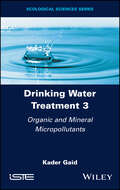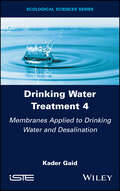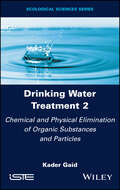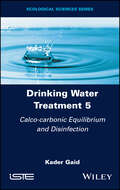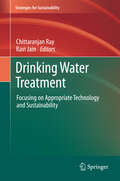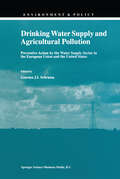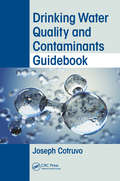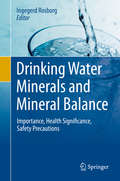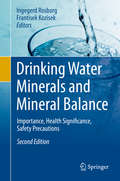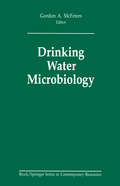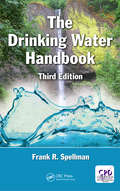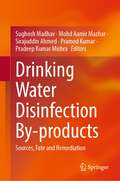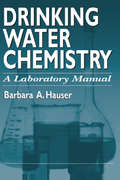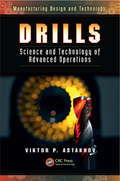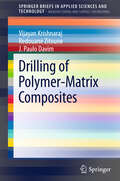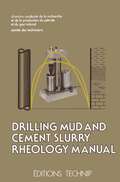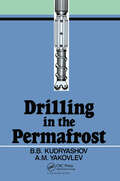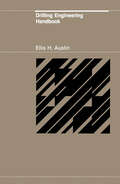- Table View
- List View
Drinking Water Treatment, Organic and Mineral Micropollutants
by Kader GaidToday, hundreds of millions of people drink contaminated water without knowing it. Yet water treatment technologies can effectively eliminate contamination and can supply urban and rural populations with safe drinking water in a secure way. For almost two centuries, the huge number of treatments available to guarantee water quality has grown alongside technological progress, the strengthening of industry norms and the reinforcement of consumer expectations. New treatment methods have been developed according to the advancement of knowledge and new sanitary regulations. This five-volume book sets out to clearly present the variety of treatments available along with their performance, limitations and conditions of use as well as ways to combine them to produce safe drinking water, which is a basic need essential to everyday life. The author shares his expertise acquired at Veolia, a company that is a world leader in water services and sanitation, desalination of sea water and the recycling of wastewater. Founded in France in 1853 to bring safe water to populations and to protect them from waterborne epidemics which ravaged cities, its history is intertwined with that of water treatment.
Drinking Water Treatment, Organic and Mineral Micropollutants
by Kader GaidToday, hundreds of millions of people drink contaminated water without knowing it. Yet water treatment technologies can effectively eliminate contamination and can supply urban and rural populations with safe drinking water in a secure way. For almost two centuries, the huge number of treatments available to guarantee water quality has grown alongside technological progress, the strengthening of industry norms and the reinforcement of consumer expectations. New treatment methods have been developed according to the advancement of knowledge and new sanitary regulations. This five-volume book sets out to clearly present the variety of treatments available along with their performance, limitations and conditions of use as well as ways to combine them to produce safe drinking water, which is a basic need essential to everyday life. The author shares his expertise acquired at Veolia, a company that is a world leader in water services and sanitation, desalination of sea water and the recycling of wastewater. Founded in France in 1853 to bring safe water to populations and to protect them from waterborne epidemics which ravaged cities, its history is intertwined with that of water treatment.
Drinking Water Treatment, Membranes Applied to Drinking Water and Desalination
by Kader GaidToday, hundreds of millions of people drink contaminated water without knowing it. Yet water treatment technologies can effectively eliminate contamination and can supply urban and rural populations with safe drinking water in a secure way. For almost two centuries, the huge number of treatments available to guarantee water quality has grown alongside technological progress, the strengthening of industry norms and the reinforcement of consumer expectations. New treatment methods have been developed according to the advancement of knowledge and new sanitary regulations. This five-volume book sets out to clearly present the variety of treatments available along with their performance, limitations and conditions of use as well as ways to combine them to produce safe drinking water, which is a basic need essential to everyday life. The author shares his expertise acquired at Veolia, a company that is a world leader in water services and sanitation, desalination of sea water and the recycling of wastewater. Founded in France in 1853 to bring safe water to populations and to protect them from waterborne epidemics which ravaged cities, its history is intertwined with that of water treatment.
Drinking Water Treatment, Membranes Applied to Drinking Water and Desalination
by Kader GaidToday, hundreds of millions of people drink contaminated water without knowing it. Yet water treatment technologies can effectively eliminate contamination and can supply urban and rural populations with safe drinking water in a secure way. For almost two centuries, the huge number of treatments available to guarantee water quality has grown alongside technological progress, the strengthening of industry norms and the reinforcement of consumer expectations. New treatment methods have been developed according to the advancement of knowledge and new sanitary regulations. This five-volume book sets out to clearly present the variety of treatments available along with their performance, limitations and conditions of use as well as ways to combine them to produce safe drinking water, which is a basic need essential to everyday life. The author shares his expertise acquired at Veolia, a company that is a world leader in water services and sanitation, desalination of sea water and the recycling of wastewater. Founded in France in 1853 to bring safe water to populations and to protect them from waterborne epidemics which ravaged cities, its history is intertwined with that of water treatment.
Drinking Water Treatment, Chemical and Physical Elimination of Organic Substances and Particles
by Kader GaidToday, hundreds of millions of people drink contaminated water without knowing it. Yet water treatment technologies can effectively eliminate contamination and can supply urban and rural populations with safe drinking water in a secure way.For almost two centuries, the huge number of treatments available to guarantee water quality has grown alongside technological progress, the strengthening of industry norms and the reinforcement of consumer expectations. New treatment methods have been developed according to the advancement of knowledge and new sanitary regulations.This five-volume book sets out to clearly present the variety of treatments available along with their performance, limitations and conditions of use as well as ways to combine them to produce safe drinking water, which is a basic need essential to everyday life.The author shares his expertise acquired at Veolia, a company that is a world leader in water services and sanitation, desalination of sea water and the recycling of wastewater. Founded in France in 1853 to bring safe water to populations and to protect them from waterborne epidemics which ravaged cities, its history is intertwined with that of water treatment.
Drinking Water Treatment, Chemical and Physical Elimination of Organic Substances and Particles
by Kader GaidToday, hundreds of millions of people drink contaminated water without knowing it. Yet water treatment technologies can effectively eliminate contamination and can supply urban and rural populations with safe drinking water in a secure way.For almost two centuries, the huge number of treatments available to guarantee water quality has grown alongside technological progress, the strengthening of industry norms and the reinforcement of consumer expectations. New treatment methods have been developed according to the advancement of knowledge and new sanitary regulations.This five-volume book sets out to clearly present the variety of treatments available along with their performance, limitations and conditions of use as well as ways to combine them to produce safe drinking water, which is a basic need essential to everyday life.The author shares his expertise acquired at Veolia, a company that is a world leader in water services and sanitation, desalination of sea water and the recycling of wastewater. Founded in France in 1853 to bring safe water to populations and to protect them from waterborne epidemics which ravaged cities, its history is intertwined with that of water treatment.
Drinking Water Treatment, Calco-carbonic Equilibrium and Disinfection
by Kader GaidToday, hundreds of millions of people drink contaminated water without knowing it. Yet water treatment technologies can effectively eliminate contamination and can supply urban and rural populations with safe drinking water in a secure way. For almost two centuries, the huge number of treatments available to guarantee water quality has grown alongside technological progress, the strengthening of industry norms and the reinforcement of consumer expectations. New treatment methods have been developed according to the advancement of knowledge and new sanitary regulations. This five-volume book sets out to clearly present the variety of treatments available along with their performance, limitations and conditions of use as well as ways to combine them to produce safe drinking water, which is a basic need essential to everyday life. The author shares his expertise acquired at Veolia, a company that is a world leader in water services and sanitation, desalination of sea water and the recycling of wastewater. Founded in France in 1853 to bring safe water to populations and to protect them from waterborne epidemics which ravaged cities, its history is intertwined with that of water treatment.
Drinking Water Treatment, Calco-carbonic Equilibrium and Disinfection
by Kader GaidToday, hundreds of millions of people drink contaminated water without knowing it. Yet water treatment technologies can effectively eliminate contamination and can supply urban and rural populations with safe drinking water in a secure way. For almost two centuries, the huge number of treatments available to guarantee water quality has grown alongside technological progress, the strengthening of industry norms and the reinforcement of consumer expectations. New treatment methods have been developed according to the advancement of knowledge and new sanitary regulations. This five-volume book sets out to clearly present the variety of treatments available along with their performance, limitations and conditions of use as well as ways to combine them to produce safe drinking water, which is a basic need essential to everyday life. The author shares his expertise acquired at Veolia, a company that is a world leader in water services and sanitation, desalination of sea water and the recycling of wastewater. Founded in France in 1853 to bring safe water to populations and to protect them from waterborne epidemics which ravaged cities, its history is intertwined with that of water treatment.
Drinking Water Treatment: Focusing on Appropriate Technology and Sustainability (Strategies for Sustainability)
by Chittaranjan Ray and Ravi JainSustainable technologies for water supply are urgently needed if water has to be supplied to billions of less fortunate people with inadequate access to water. These technologies must be simple, less expensive, less energy intensive, and easy to maintain for their adaptation among the poor masses. Four appropriate technologies are discussed here: solar pasteurization, membrane desalination, natural filtration (riverbank filtration), and solar distillation. Solar pasteurization can be a useful means of producing water at remote, but sunny locations where fuel may not be easily available for boiling water. Membrane desalination will remain as a viable means of drinking water production for individual households to large communities. Various membrane filtration techniques as well as the means to “democratize” membrane filtration have been presented. Riverbank filtration is a “natural” filtration technique where drinking water is produced by placing wells on the banks of rivers. The riverbed/bank material and the underlying aquifer act as natural filters to remove pollutants from river water. Solar distillation can be a viable method of drinking water production for individual households to small communities without the input of external energy. Sustainability framework and technology transfer are discussed through transdisciplinary analysis.
Drinking Water Supply and Agricultural Pollution: Preventive Action by the Water Supply Sector in the European Union and the United States (Environment & Policy #11)
by Geerten J. I. SchramaAgricultural pollution (with nitrates and pesticides) is one of the biggest threats to drinking water resources. At many places regional and local water authorities, together with the water supply industry, are involved in preventive action aimed at farming practices. Three national case studies (Germany, The Netherlands, and the United Kingdom) analyse these efforts within the context of problematical national agricultural policy and the need to implement EU directives on water quality. Additional case studies cover the role of the European Union, while the same problem in a different setting is analysed for the United States. The central question of how national and European governments can reinforce the control capacity of the actors at the regional and local level, is treated from the theoretical perspective of the policy network approach.
Drinking Water Quality and Contaminants Guidebook
by Joseph CotruvoK347191 BCC Drinking water quality is a sensitive issue, and the public is constantly barraged by contaminant reports now routinely at parts-per-trillion. Protection from microbial disease risks from drinking water must always be predominant; trace chemicals usually fall farther down the scale of possible health risks, but even negligible detections raise public concerns. Drinking Water Quality and Contaminants Guidebook presents information and guidance on drinking water quality and regulatory issues reflecting experiences and judgments from the author’s more than 43 years of extensive experience. It contains digested comprehensive information on important chemical, microbial, and radionuclide water contaminants, and discussions of several drinking water-related policy issues. Information is presented for long-standing regulated contaminants and chemicals of emerging concern in understandable terms for professionals and non-experts alike. Dossiers contain readily accessed information on sources, physical and chemical properties, toxicity, analytical methodology, water treatment technology, regulations and health advisories, and also include World Health Organization Guidelines. Aesthetic and acceptance factors such as water hardness and salinity that influence public perceptions of drinking water quality are also addressed. Features: Compiles and interprets essential information on numerous key chemical, microbial, and radionuclide water contaminants Provides standardized entries for each contaminant, including occurrence, health, analytical, water treatment, regulations, and World Health Organization guidance and recommendations with source citations Examines many water-related topics including fracking, potable water reuse, desalination, boil water notices, bottled water, foodborne and waterborne disease, and public perceptions about public drinking water quality Provides essential information and the basis for management of many long-standing contaminants such as lead, mercury, disinfection by-products, E. coli, and also emerging issues such as legionella, glyphosate, BPA, and more
Drinking Water Quality and Contaminants Guidebook
by Joseph CotruvoK347191 BCC Drinking water quality is a sensitive issue, and the public is constantly barraged by contaminant reports now routinely at parts-per-trillion. Protection from microbial disease risks from drinking water must always be predominant; trace chemicals usually fall farther down the scale of possible health risks, but even negligible detections raise public concerns. Drinking Water Quality and Contaminants Guidebook presents information and guidance on drinking water quality and regulatory issues reflecting experiences and judgments from the author’s more than 43 years of extensive experience. It contains digested comprehensive information on important chemical, microbial, and radionuclide water contaminants, and discussions of several drinking water-related policy issues. Information is presented for long-standing regulated contaminants and chemicals of emerging concern in understandable terms for professionals and non-experts alike. Dossiers contain readily accessed information on sources, physical and chemical properties, toxicity, analytical methodology, water treatment technology, regulations and health advisories, and also include World Health Organization Guidelines. Aesthetic and acceptance factors such as water hardness and salinity that influence public perceptions of drinking water quality are also addressed. Features: Compiles and interprets essential information on numerous key chemical, microbial, and radionuclide water contaminants Provides standardized entries for each contaminant, including occurrence, health, analytical, water treatment, regulations, and World Health Organization guidance and recommendations with source citations Examines many water-related topics including fracking, potable water reuse, desalination, boil water notices, bottled water, foodborne and waterborne disease, and public perceptions about public drinking water quality Provides essential information and the basis for management of many long-standing contaminants such as lead, mercury, disinfection by-products, E. coli, and also emerging issues such as legionella, glyphosate, BPA, and more
Drinking Water Minerals and Mineral Balance: Importance, Health Significance, Safety Precautions
by Ingegerd RosborgThe various safety organizations working on drinking water all warn about unhealthy constituents, as well as elements that can cause corrosion or scaling on pipes and installations. However, drinking water may also provide a substantial portion of the daily mineral intake, especially for the elderly and children, or those at risk of deficiencies due to unhealthy eating habits or starvation. Thus, a holistic approach to drinking water is presented in this book and the scope is extended from standards for undesirable substances to the basic mineral composition of water, examining 22 nutrient elements and ions and 21 toxic substances. The function of the nutrients in the body, symptoms of deficiency and overload, and advantages of the minerals from drinking water are presented, as well as symptoms of toxic elements from drinking water. The authors also suggest healthy ranges of minerals and mineral ratios for drinking water. The book offers a valuable resource for the health evaluation of drinking waters, for private well owners, public water producers and safety organizations alike.
Drinking Water Minerals and Mineral Balance: Importance, Health Significance, Safety Precautions
by Ingegerd Rosborg Frantisek KozisekFollowing the successful first edition of this book on drinking water quality and health, this new edition puts more focus on the importance of minerals in drinking water. It includes new scientific material and presents additional studies on the negative health effects of reverse osmosis water. The various safety organizations working on drinking water all warn about unhealthy constituents, as well as elements that can cause corrosion or scaling on pipes and installations. However, drinking water may also provide a substantial portion of the daily mineral intake, especially for the elderly and children, or those at risk of deficiencies due to unhealthy eating habits or starvation. Thus, a holistic approach to drinking water is presented in this book and the scope is extended from standards for undesirable substances to the basic mineral composition of water, examining 22 nutrient elements and ions and 21 toxic substances. The function of the nutrients in the body, symptoms of deficiency and overload, and advantages of the minerals from drinking water are presented, as well as symptoms of toxic elements from drinking water. The authors also suggest healthy ranges of minerals and mineral ratios for drinking water. The book offers a valuable resource for the health evaluation of drinking waters, for private well owners, public water producers and safety organizations alike.
Drinking Water Microbiology: Progress and Recent Developments (Brock Springer Series in Contemporary Bioscience)
by Gordon A. McFetersThe microbiology of drinking water remains an important worldwide concern despite modem progress in science and engineering. Countries that are more technologically advanced have experienced a significant reduction in water borne morbidity within the last 100 years: This reduction has been achieved through the application of effective technologies for the treatment, disinfec tion, and distribution of potable water. However, morbidity resulting from the ingestion of contaminated water persists globally, and the available ep idemiological evidence (Waterborne Diseases in the United States, G. F. Craun, ed. , 1986, CRC Press) demonstrates a dramatic increase in the number of waterborne outbreaks and individual cases within the United States since the mid-1960s. In addition, it should also be noted that the incidence of water borne outbreaks of unknown etiology and those caused by "new" pathogens, such as Campylobaeter sp. , is also increasing in the United States. Although it might be debated whether these increases are real or an artifact resulting from more efficient reporting, it is clear that waterborne morbidity cannot be ignored in the industrialized world. More significantly, it represents one of the most important causes of illness within developing countries. Approxi mately one-half the world's population experiences diseases that are the direct consequence of drinking polluted water. Such illnesses are the primary cause of infant mortality in many Third World countries.
The Drinking Water Handbook
by Frank R. SpellmanThis new edition of The Drinking Water Handbook is thoroughly revised and updated, and includes a comprehensive discussion of the Flint, Michigan lead contamination event, new coverage of contaminants in water, such as personal care products and pharmaceuticals (PCPP) and endocrine disruptors, and examines the security requirements for waterworks and ancillary procedures. It examines the process of producing drinking water— from sources of water, to the purification process, through distribution systems to the tap, and then to the actual use and reuse of water. It also reflects the latest advancements in treatment technologies and reviews new laws and regulations related to drinking water.
The Drinking Water Handbook
by Frank R. SpellmanThis new edition of The Drinking Water Handbook is thoroughly revised and updated, and includes a comprehensive discussion of the Flint, Michigan lead contamination event, new coverage of contaminants in water, such as personal care products and pharmaceuticals (PCPP) and endocrine disruptors, and examines the security requirements for waterworks and ancillary procedures. It examines the process of producing drinking water— from sources of water, to the purification process, through distribution systems to the tap, and then to the actual use and reuse of water. It also reflects the latest advancements in treatment technologies and reviews new laws and regulations related to drinking water.
Drinking Water Disinfection By-products: Sources, Fate and Remediation
by Sughosh Madhav Mohd Aamir Mazhar Sirajuddin Ahmed Pramod Kumar Pradeep Kumar MishraThis book is devoted to water treatment and it outlines the historical context and regulatory framework surrounding drinking water chlorination, addressing disinfection by-products (DBPs) formation, associated challenges and implications on water quality and human health. In this book, readers will find an overview of various disinfection processes and the latest strategies in DBPs detection and remediation. Divided into 14 chapters, the book begins by offering a background analysis of water disinfection and comparing different disinfection processes and management strategies to mitigate the formation of DBPs. Particular attention is given to both conventional and non-conventional methods used to treat potable water, comparing their effectiveness and potential risks. In subsequent chapters, expert contributors outline the route of exposure and mechanism of action of DBPs, and the toxicological impact of DBPs on human health, providing essential insights for effective risk management strategies. This book also showcases the latest advancements in chlorine applications for water quality control and explores innovative physicochemical and nanotechnology-based approaches to remove DBPs and minimize their formation. Readers will also find in this book a case study of the GIS-based trends analysis of THMs compounds in Indian drinking water supplies. Given its breadth, this book is a valuable resource for researchers, academics, professionals, and policymakers working in environmental sciences, public health and water management, and interested in safer and sustainable drinking water practices.
Drinking Water Chemistry: A Laboratory Manual
by Barbara HauserWhether you are a new employee or seasoned professional you need easy access to the latest test methods, updated quality control procedures, and calculations at your fingertips. You need to perform analyses quickly and easily and troubleshoot problems as they arise. You need a resource that is not only informative, but also practical and easy to use. Drinking Water Chemistry: A Laboratory Manual fills this need.The book gives you a thorough overview of the most basic, and therefore important, laboratory topics such as:Laboratory Safety - dos and don'ts based on real experienceSampling - preservation techniques, online sampling, and record keepingLaboratory Instruments - practical use ranges, principles of operation, calibration, conditioning, useful life and replacement, common quality control issuesChemical Use - reagents, standards, indicators, purpose and use, chemical quality and properties, avoidance of contamination, molecular weight calculationsQuality Control - replicate analyses, spiked, split, and reference samples, percent recovery of standard, standard deviation, control charts, and everyday quality control measuresWeights and Concentrations - care and analytical balances, mathematical conversions among concentration units, dilutions and concentration changesThe remaining chapters cover test analysis including: reason for the test, type of sample taken, treatment plant control significance, expected range of results, appropriate quality control procedures, apparatus used, reagents, including function, concentration and instructions for preparation, procedural steps, calculations and notes on possible problems, and references. This is a working manual, meant to be kept by your side in the lab, not on the shelf in an office or library. You can bend it, you can lay it flat, you can take it anywhere you do your job. Useful and practical Drinking Water Chemistry: A Laboratory Manual provides the information you need to perform tests, understand the results, apply them to the determination of water quality before and after treatment, and troubleshoot any problems.
Drills: Science and Technology of Advanced Operations
by Viktor P. AstakhovIn a presentation that balances theory and practice, Drills: Science and Technology of Advanced Operations details the basic concepts, terminology, and essentials of drilling. The book addresses important issues in drilling operations, and provides help with the design of such operations. It debunks many old notions and beliefs while introducing sc
Drilling of Polymer-Matrix Composites (SpringerBriefs in Applied Sciences and Technology)
by Vijayan Krishnaraj Redouane Zitoune J. Paulo DavimThis brief focus on drilling of polymer matrix composites for aerospace and defence applications. It gives an introduction to machining of polymer composites and discusses drilling as a processing of composites.
Drilling Mud and Cement Slurry Rheology Manual: Publication de la Chambre Syndicale de la Recherche et de la Production du Pétrole et du Gaz Naturel
by Comité des Techniciens, Chambre Syndicale de la Recherche et de la Production du Pétrole et du Gaz NaturelDrilling in the Permafrost: Russian Translations Series, volume 84
by B.B. Kudyashov A.M. YakovlevFirst published in 1991. This volume presents a brief description of the natural conditions of the permafrost regions, the properties of the permafrost and the processes occurring in it, the fundamentals of the heat transfer processes during drilling and the service temperature conditions of the tool. Methods and devices for cooling the flushing media, principles of quality control of flushing agents and the technology and commercial viability of their use during drilling in the permafrost have been considered. The main emphasis in this book is on the drilling technology which uses a variety of flushing agents. The text also includes a description of the technology of utilizing grouting solutions, the theory and practice of drilling with simultaneous freezing of weakly cohesive, moist ground as well as jdrilling holes in the ice-sheets of the circumpolar regions. This book is intended for engineers and technical personnel engaged in drilling for exploratory geological works.
Drilling in the Permafrost: Russian Translations Series, volume 84
by B.B. Kudyashov A.M. YakovlevFirst published in 1991. This volume presents a brief description of the natural conditions of the permafrost regions, the properties of the permafrost and the processes occurring in it, the fundamentals of the heat transfer processes during drilling and the service temperature conditions of the tool. Methods and devices for cooling the flushing media, principles of quality control of flushing agents and the technology and commercial viability of their use during drilling in the permafrost have been considered. The main emphasis in this book is on the drilling technology which uses a variety of flushing agents. The text also includes a description of the technology of utilizing grouting solutions, the theory and practice of drilling with simultaneous freezing of weakly cohesive, moist ground as well as jdrilling holes in the ice-sheets of the circumpolar regions. This book is intended for engineers and technical personnel engaged in drilling for exploratory geological works.
Drilling Engineering Handbook
by E.H. AustinThis book presents the fundamental principles of drilling en gineering, with the primary objective of making a good well using data that can be properly evaluated through geology, reservoir engineering, and management. It is written to assist the geologist, drilling engineer, reservoir engineer, and manager in performing their assignments. The topics are introduced at a level that should give a good basic understanding of the subject and encourage further investigation of specialized interests. Many organizations have separate departments, each per forming certain functions that can be done by several methods. The reentering of old areas, as the industry is doing today, particularly emphasizes the necessity of good holes, logs, casing design, and cement job. Proper planning and coordination can eliminate many mistakes, and I hope the topics discussed in this book will playa small part in the drilling of better wells. This book was developed using notes, comments, and ideas from a course I teach called "Drilling Engineering with Offshore Considerations." Some "rules of thumb" equations are used throughout, which have proven to be helpful when applied in the ix x / Preface proper perspective. The topics are presented in the proper order for carrying through the drilling of a well.
